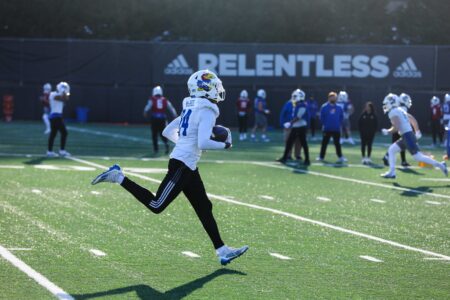KU’s creative run game on display in near-upset of Kansas State

Kansas running back Daniel Hishaw Jr. (20) tries to stiff arm Kansas State defensive end Nate Matlack (97) during the first quarter on Saturday Nov. 18, 2023 at Memorial Stadium. Photo by Nick Krug
Freshman quarterback Cole Ballard, a former walk-on who was recently given a scholarship, became the third different Kansas quarterback to make a start this season in Saturday’s 31-27 loss to Kansas State at David Booth Kansas Memorial Stadium.
Despite the QB carousel, the Jayhawks have continued to produce results on the offensive end. The Ballard-led offense scored 27 points (all within the first 32 minutes) and averaged 6.9 yards per play — tied for the highest clip against Kansas State this year.
A big part of KU’s offensive success was the run game. Kansas accumulated 234 yards and three touchdowns on 41 rushing attempts in 57 offensive plays. It marked the most yards and scores recorded on the ground against K-State all season.
“We talked about it all week that we need to do better with overwhelming those guys,” said Kansas running back Devin Neal, who led the way with 138 yards and three scores. “(The offensive linemen) were able to create a lot of push and we were able to do our job as running backs.”
“Every inch, every yard matters,” Neal added. “We took that to heart this week.”
But what really stood out from a strong rushing performance was the creativity of the play-calling against a formidable 3-3-5 KSU defensive scheme.
Offensive coordinator Andy Kotelnicki’s scheme typically uses a lot of motion and misdirection to put his players in the best position, which has included plenty of wildcat packages over the last few weeks. The wildcat describes a formation where the ball is snapped directly to a player that isn’t the quarterback, such as a running back or receiver.
The Jayhawks utilized this look more than usual against Kansas State. Of their 41 rushing attempts, 16 came on plays featuring a direct snap to someone other than Ballard. Kansas recorded positive yardage on 14 of those attempts, netting a total of 73 yards for an average of 4.6 yards per play on wildcat snaps.
Neal, Daniel Hishaw Jr. and Torry Locklin were all involved in wildcat packages.
“I think it’s cool all the things we can do and all that Coach K can really scheme up for those guys to get the ball in playmakers’ hands,” Ballard said. “I think it’s really cool just to see those guys work.”
The Jayhawks started using direct snaps on their opening drive, when they didn’t call a single pass for Ballard during a three-and-out. On third-and-3, Locklin ran a speed option to the left after receiving the direct snap before netting just two yards. The second wildcat play resulted in a loss of two yards for Hishaw on an option run.
After that, the wildcat package had more success. Neal netted six yards on his first rushing attempt via a direct snap. He was responsible for 46 yards on nine attempts in the wildcat formation, highlighted by a 9-yard touchdown run in the second quarter and a 10-yard gain in the third quarter.
“I kind of like controlling the offense a little bit,” Neal said. “I just think for me, it helps me see things a little bit quicker versus taking a handoff and having to see it. Being able to see the whole thing quicker helps.”
Neal has attempted the lone pass out of the wildcat formation to this point, which resulted in a red-zone incompletion during a Week 11 loss to Texas Tech. Aside from that, the personnel package has been mostly predictable and featured exclusively runs.
For example, Locklin was given a direct snap seven different times against K-State. All seven plays were speed options to the left, but each one produced positive yardage. Locklin kept it four times for 19 yards, including a 10-yard run on 3rd-and-2 during the third quarter. He also pitched it a few times, one of which occurred on Neal’s TD run in the second period.
“It gives them time to make a play and they do what they want to do,” Ballard said. “I think that’s really cool that Coach K has the faith in Torry and Devin to just run the speed option. That’s unheard of from someone other than the quarterback.”
The Jayhawks also ran different variations off the wildcat look throughout the game. Ballard occasionally started as a wide receiver before motioning back to behind the center. Perhaps the most-creative play occurred in the second quarter, when Hishaw picked up a first down with a 4-yard run on 3rd-and-3.
Ballard clapped twice in anticipation of the snap before making his way toward the sideline for the play call. After taking a couple steps, Ballard clapped once more and the ball was snapped to Hishaw, who immediately pushed through the KSU defensive line.
It was an example of how the Jayhawks pulled out all the tricks to produce a near-perfect offensive game plan in an attempt to upset the Wildcats.
According to Game on Paper, Kansas averaged 0.25 EPA per play (86th percentile) and a 53% success rate (93rd percentile) on offense. Both marks were better than K-State’s clip of 0.08 EPA/play and 40% success rate. Per SP+, the Jayhawks had a 55.9% post-game win expectancy.
It just wasn’t enough, as KU dropped a 15th straight game in the Sunflower Showdown.
“We just didn’t execute good enough,” Neal said. “Closing the gap to those guys is super important to us, but obviously our wish was to break that losing streak against them. It’s disappointing, for sure, but we are going to bounce back.”







